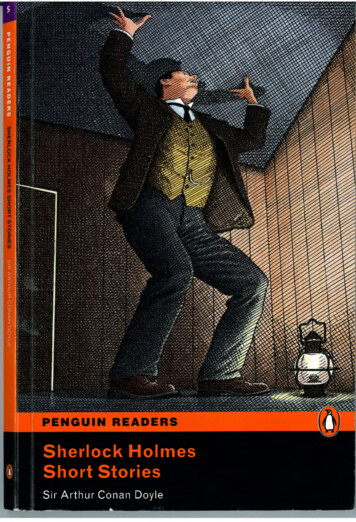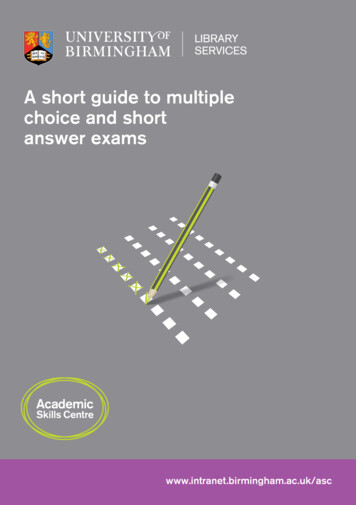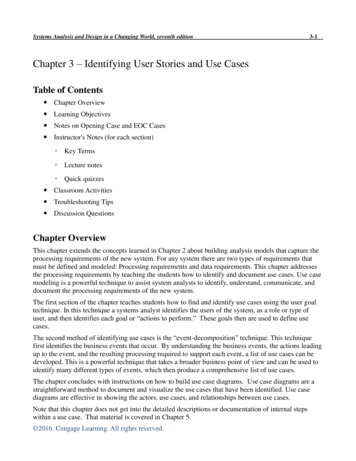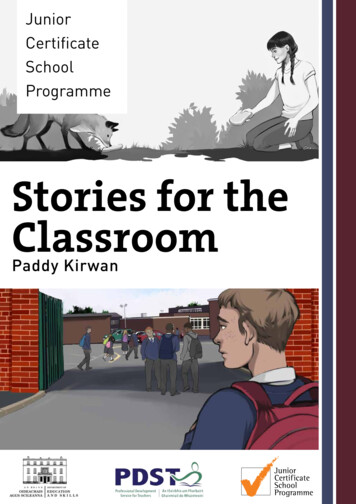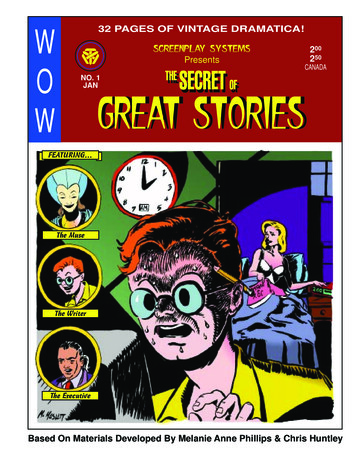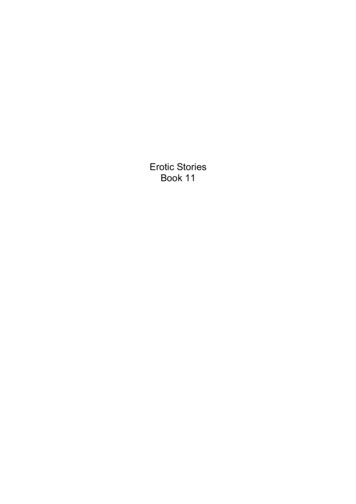
Transcription
BOOKS BY ERNEST HEMINGWAYThe Complete Short StoriesThe Garden of EdenDateline: TorontoThe Dangerous SummerSelected LettersThe Enduring HemingwayThe Nick Adams StoriesIslands in the StreamThe Fifth Column and Four Stories of the Spanish Civil WarBy-Line: Ernest HemingwayA Moveable FeastThree NovelsThe Snows of Kilimanjaro and Other StoriesThe Hemingway ReaderThe Old Man and the SeaAcross the River and into the TreesFor Whom the Bell TollsThe Short Stories of Ernest HemingwayTo Have and Have NotGreen Hills of AfricaWinner Take NothingDeath in the AfternoonIn Our TimeA Farewell to ArmsMen Without WomenThe Sun Also RisesThe Torrents of Spring
TheCompleteShort Stories ofErnest Hemingway
SCRIBNER1230 Avenue of the AmericasNew York, NY 10020This book is a work of fiction. Names, characters, places, and incidentseither are products of the author’s imagination or are used fictitiously.Any resemblance to actual events or locales or persons, living or dead,is entirely coincidental.Copyright 1987 by Simon & Schuster Inc.All rights reserved, including the right of reproduction inwhole or in part in any form.and design are trademarksof Macmillan Library Reference USA, Inc., used under licenseby Simon & Schuster, the publisher of this work.SCRIBNERLibrary of Congress Gilahging-in-Publication DataHemingway Ernest, 1899-1961.[Short stories]The complete short stories of Ernest Hemingway / ErnestHemingway.—Finca Vigía ed.p. cm.I. Title.PS3515E37A15 1991813′.52—dc20 90-26241CIPISBN-13: 978-1-4165-8729-3ISBN-10: 1-4165-8729-2Visit us on the World Wide Web:http://www.SimonSays.com
ContentsForewordPublisher’s PrefacePART I “The First Forty-nine”Preface to “The First Forty-nine”The Short Happy Life of Francis MacomberThe Capital of the WorldThe Snows of KilimanjaroOld Man at the BridgeUp in MichiganOn the Quai at SmyrnaIndian CampThe Doctor and the Doctor’s WifeThe End of SomethingThe Three-Day BlowThe BattlerA Very Short StorySoldier’s HomeThe RevolutionistMr. and Mrs. ElliotCat in the RainOut of SeasonCross-Country SnowMy Old ManBig Two-Hearted River: Part IBig Two-Hearted River: Part IIThe UndefeatedIn Another CountryHills Like White ElephantsThe KillersChe Ti Dice La Patria?Fifty Grand
A Simple EnquiryTen IndiansA Canary for OneAn Alpine IdyllA Pursuit RaceToday Is FridayBanal StoryNow I Lay MeAfter the StormA Clean, Well-Lighted PlaceThe Light of the WorldGod Rest You Merry, GentlemenThe Sea ChangeA Way You’ll Never BeThe Mother of a QueenOne Reader WritesHomage to SwitzerlandA Day’s WaitA Natural History of the DeadWine of WyomingThe Gambler, the Nun, and the RadioFathers and SonsPART II Short Stories Published in Books orMagazines Subsequent to “The First Forty-nine”One Trip AcrossThe Tradesman’s ReturnThe DenunciationThe Butterfly and the TankNight Before BattleUnder the RidgeNobody Ever DiesThe Good LionThe Faithful BullGet a Seeing-Eyed DogA Man of the WorldSummer PeopleThe Last Good Country
An African StoryPART III Previously Unpublished FictionA Train TripThe PorterBlack Ass at the Cross RoadsLandscape with FiguresI Guess Everything Reminds You of SomethingGreat News from the MainlandThe Strange Country
ForewordWHEN PAPA AND MARTY FIRST RENTED in 1940 the FincaVigía which was to be his home for the next twenty-two years until his death, there was still a realcountry on the south side. This country no longer exists. It was not done in by middle-class real estatedevelopers like Chekhov’s cherry orchard, which might have been its fate in Puerto Rico or Cubawithout the Castro revolution, but by the startling growth of the population of poor people and theirshack housing which is such a feature of all the Greater Antilles, no matter what their politicalpersuasion.As children in the very early morning lying awake in bed in our own little house that Marty hadfixed up for us, we used to listen for the whistling call of the bobwhites in that country to the south.It was a country covered in manigua thicket and in the tall flamboyante trees that grew along thewatercourse that ran through it, wild guinea fowl used to come and roost in the evening. They wouldbe calling to each other, keeping in touch with each other in the thicket, as they walked and scratchedand with little bursts of running moved back toward their roosting trees at the end of their day’sforaging in the thicket.Manigua thicket is a scrub acacia thornbush from Africa, the first seeds of which the Creolessay came to the island between the toes of the black slaves. The guinea fowl were from Africa too.They never really became as tame as the other barnyard fowl the Spanish settlers brought with themand some escaped and throve in the monsoon tropical climate, just as Papa told us some of the blackslaves had escaped from the shipwreck of slave ships on the coast of South America, enough of themtogether with their culture and language intact so that they were able to live together in the wildernessdown to the present day just as they had lived in Africa.Vigía in Spanish means a lookout or a prospect. The farmhouse is built on a hill that commandsan unobstructed view of Havana and the coastal plain to the north. There is nothing African or evencontinental about this view to the north. It is a Creole island view of the sort made familiar by thetropical watercolors of Winslow Homer, with royal palms, blue sky, and the small, white cumulusclouds that continuously change in shape and size at the top of the shallow northeast trade wind, thebrisa.In the late summer, when the doldrums, following the sun, move north, there are often, as the heatbuilds in the afternoons, spectacular thunderstorms that relieve for a while the humid heat, chubascosthat form inland to the south and move northward out to the sea.In some summers, a hurricane or two would cut swaths through the shack houses of the poor onthe island. Hurricane victims, damnificados del ciclón, would then add a new tension to localpolitics, already taut enough under the strain of insufficient municipal water supplies, perceivedoutrages to national honor like the luridly reported urination on the monument to José Marti bydrunken American servicemen and, always, the price of sugar.Lightning must still strike the house many times each summer, and when we were children thereno one would use the telephone during a thunderstorm after the time Papa was hurled to the floor inthe middle of a call, himself and the whole room glowing in the blue light of Saint Elmo’s fire.During the early years at the finca, Papa did not appear to write any fiction at all. He wrote
many letters, of course, and in one of them he says that it is his turn to rest. Let the world get on withthe mess it had gotten itself into.Marty was the one who seemed to write and to have kept her taste for the high excitement of theirlife together in Madrid during the last period of the Spanish Civil War. Papa and she played a lot oftennis with each other on the clay court down by the swimming pool and there were often tennisparties with their friends among the Basque professional jai alai players from the fronton in Havana.One of these was what the young girls today would call a hunk, and Marty flirted with him a little andPapa spoke of his rival, whom he would now and again beat at tennis by the lowest form of cunningexpressed in spins and chops and lobs against the towering but uncontrolled honest strength of therival.It was all great fun for us, the deep-sea fishing on the Pilar that Gregorio Fuentes, the mate, keptalways ready for use in the little fishing harbor of Cojimar, the live pigeon shooting at the Club deCazadores del Cerro, the trips into Havana for drinks at the Floridita and to buy The IllustratedLondon News with its detailed drawings of the war so far away in Europe.Papa, who was always very good at that sort of thing, suggested a quotation from Turgenev toMarty: “The heart of another is a dark forest,” and she used part of it for the title of a work of fictionshe had just completed at the time.Although the Finca Vigía collection contains all the stories that appeared in the firstcomprehensive collection of Papa’s short stories published in 1938, those stories are now wellknown. Much of this collection’s interest to the reader will no doubt be in the stories that werewritten or only came to light after he came to live at the Finca Vigía.—JOHN, PATRICK, AND GREGORY HEMINGWAY 1987
Publisher’s PrefaceTHERE HAS LONG BEEN A NEED FOR A complete and up-to-dateedition of the short stories of Ernest Hemingway. Until now the only such volume was the omnibuscollection of the first forty-nine stories published in 1938 together with Hemingway’s play The FifthColumn. That was a fertile period of Hemingway’s writing and a number of stories based on hisexperiences in Cuba and Spain were appearing in magazines, but too late to have been included in“The First Forty-nine.”In 1939 Hemingway was already considering a new collection of stories that would take itsplace beside the earlier books In Our Time, Men Without Women , and Winner Take Nothing . OnFebruary 7 he wrote from his home in Key West to his editor Maxwell Perkins at Scribnerssuggesting such a book. At that time he had already completed five stories: “The Denunciation,” “TheButterfly and the Tank,” “Night Before Battle,” “Nobody Ever Dies,” and “Landscape with Figures,”which is published here for the first time. A sixth story, “Under the Ridge,” would appear shortly inthe March 1939 edition of Cosmopolitan.As it turned out, Hemingway’s plans for that new book did not pan out. He had committedhimself to writing three “very long” stories to round out the collection (two dealing with battles in theSpanish Civil War and one about the Cuban fisherman who fought a swordfish for four days and fournights only to lose it to sharks). But once Hemingway got underway on his novel—later published asFor Whom the Bell Tolls —all other writing projects were laid aside. We can only speculate on thetwo war stories he abandoned, but it is probable that much of what they might have included found itsway into the novel. As for the story of the Cuban fisherman, he did eventually return to it thirteenyears later when he developed and transformed it into his famous novella, The Old Man and the Sea.Many of Hemingway’s early stories are set in northern Michigan, where his family owned acottage on Waloon Lake and where he spent his summers as a boy and youth. The group of friends hemade there, including the Indians who lived nearby, are doubtless represented in various stories, andsome of the episodes are probably based at least partly on fact. Hemingway’s aim was to conveyvividly and exactly moments of exquisite importance and poignancy, experiences that mightappropriately be described as “epiphanies.” The posthumously published “Summer People” and thefragment called “The Last Good Country” stem from this period.Later stories, also set in America, relate to Hemingway’s experiences as a husband and father,and even as a hospital patient. The cast of characters and the variety of themes became as diversifiedas the author’s own life. One special source of material was his life in Key West, where he lived inthe twenties and thirties. His encounters with the sea on his fishing boat Pilar, taken together with hiscircle of friends, were the inspiration of some of his best writing. The two Harry Morgan stories,“One Trip Across” ( Cosmopolitan, May 1934) and “The Tradesman’s Return” ( Esquire, February1936), which draw from this period, were ultimately incorporated into the novel To Have and HaveNot, but it is appropriate and enjoyable to read them as separate stories, as they first appeared.Hemingway must have been one of the most perceptive travelers in the history of literature, andhis stories taken as a whole present a world of experience. In 1918 he signed up for ambulance dutyin Italy as a member of an American Field Service unit. It was his first transatlantic journey and he
was eighteen at the time. On the day of his arrival in Milan a munitions factory blew up, and with theother volunteers in his contingent Hemingway was assigned to gather up the remains of the dead. Onlythree months later he was badly wounded in both legs and hospitalized in the American Red Crosshospital in Milan, with subsequent outpatient treatment. These wartime experiences, including thepeople he met, provided many details for his novel of World War I, A Farewell to Arms. They alsoinspired five short story masterpieces.In the 1920s he revisited Italy several times; sometimes as a professional journalist andsometimes for pleasure. His short story about a motor trip with a friend through Mussolini’s Italy,“Che Ti Dice La Patria?,” succeeds in conveying the harsh atmosphere of a totalitarian regime.Between 1922 and 1924 Hemingway made several trips to Switzerland to gather material forThe Toronto Star . His subjects included economic conditions and other practical subjects, but alsoaccounts of Swiss winter sports: bobsledding, skiing, and the hazardous luge. As in other fields.Hemingway was ahead of his compatriots in discovering places and pleasures that would becometourist attractions. At the same time, he was storing up ideas for a number of his short stories, withthemes ranging from the comic to the serious and the macabre.Hemingway attended his first bullfight, in the company of American friends, in 1923, when hemade an excursion to Madrid from Paris, where he was living at the time. From the moment the firstbull burst into the ring he was overwhelmed by the experience and left the scene a lifelong fan. Forhim the spectacle of a man pitted against a wild bull was a tragedy rather than a sport. He wasfascinated by its techniques and conventions, the skill and courage required by the toreros, and thesheer violence of the bulls. He soon became an acknowledged expert on bullfighting and wrote afamous treatise on the subject. Death in th
years later when he developed and transformed it into his famous novella, The Old Man and the Sea. Many of Hemingway’s early stories are set in northern Michigan, where his family owned a cottage on Waloon Lake and where he spent his summers as a boy and youth. The group of friends he


